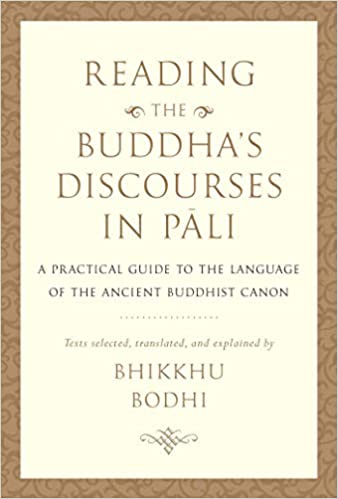Reading the Buddha's Discourses in Pali - Bhikkhu Bodhi

Available from Amazon
Preface
THE INTENTION BEHIND the present book is to help students of Early Buddhism learn to read the texts of the Pāli Canon in the ancient Indian language in which they have been preserved, the language known as Pāli. The book is based on a weekly course in Pāli that I have been conducting over the past several years at Chuang Yen Monastery in upstate New York. The course is meant for students who have completed the earlier courses I gave on the basics of Pāli grammar and the reading of the Buddha’s discourses in Pāli, the former based on Lily de Silva’s Pāli Primer, the latter on James Gair and W. S. Karunatillake’s A New Course in Reading Pāli. In the subsequent weekly course that I developed we read and analyzed suttas from the major chapters of the Saṃyutta Nikāya. In each class I took a sutta (or portion of a longer sutta), explained the meaning of each word and the grammatical forms involved, and then gave a literal translation of each sentence, followed by a more natural English rendering.
Since most of the students were already familiar with Pāli grammar, I sometimes tested their knowledge by asking them to explain the grammatical forms to the other students. Some of the students had not studied Pāli grammar and had no desire to learn it, but participated because they wanted to become familiar with the terminology of the texts and to see how translations are constructed on the basis of the original Pāli. More than half the students participated online; several even joined from Germany. All the classes were recorded, and each week I made the recordings available to the students in the class as well as to others who would have liked to join but could not attend when the class was in progress.
It occurred to me that the material I compiled during this course would make a suitable textbook for people who want to learn to read the suttas in the original language. Thus, as an experiment, I began taking a selection of the suttas that I taught, breaking them into short units of Pāli text, and writing down literal word-for-word (or phrase-by-phrase) translations, followed by more natural translations. As I proceeded, and tested the material with several friends, it became clear that such a book would serve the purpose I envisaged.
The present book, the result of that procedure, is intended for both types of students who participated in my weekly Pāli class: those who have already learned the basics of Pāli grammar and, having become acquainted with the style and terminology of the suttas, now want to progress further in their reading, and those who do not wish to study Pāli grammar but would like to gain as intimate an acquaintance with the language and idiom of the texts as is possible without studying the language grammatically.
One thing that this book is not intended to be is a Pāli primer. While I offer a brief overview of Pāli grammar and syntax, I do not provide detailed lessons in Pāli grammar in its own right. I presuppose that the reader is either already familiar with the basics of the grammar and will understand the explanations given or is not interested in the grammar as such. Those who want to learn Pāli grammar should turn to the books I used in the earlier two courses.
Nevertheless, to aid students in deciphering the grammar of the texts, I have added after each reading selection a section of grammatical explanations. These are not intended to cover every minute grammatical structure found in the text under consideration but to clarify points and principles that call for elucidation. As I progress from chapter to chapter, the grammatical explanations gradually diminish. They are intended to be progessive, the later ones building on earlier ones, and I assume that a diligent student who has become familiar with the grammatical structures and patterns explained in the earlier passages will know enough to understand what is taking place grammatically in the later passages. To avoid ambiguities, however, I occasionally repeat explanations that have come earlier and may even have gone to excess in explaining forms found in later passages that were already covered. Sometimes, however, it is better to say too much than too little.
To provide students with access to more ample explanations of the grammar, I have occasionally added references to two comprehensive Pāli grammars that I have relied on for clarification. One, available online, is Charles Duroiselle’s A Practical Grammar of the Pāli Language, originally published in Rangoon in 1906. My references to this grammar, however, cite the section numbers of the online edition rather than those in the printed edition of 1906. The other is Vito Perniola’s Pali Grammar. Both grammars cover essentially the same territory, though occasionally one will treat a topic in more detail or in a more satisfactory way than the other. I have also on occasion referred to Steven Collins’s A Pali Grammar for Students, Wilhelm Geiger’s A Pāli Grammar, especially on phonology, A. K. Warder’s Introduction to Pali, and William Dwight Whitney’s Sanskrit Grammar. Since Sanskrit and Pāli are closely related, principles that govern Sanskrit grammar are often applicable to Pāli as well.
As a preparation for the grammatical explanations attached to the individual readings, following the introduction I provide a very broad overview of Pāli grammar and another on Pāli syntax — which, while a branch of grammar, calls for special treatment. Separately, I also include a key to the terms used in the grammatical explanations. These include English terms used with specific reference to Pāli grammar, which are likely to be unfamiliar even to a well-educated reader. After all, apart from those familiar with the grammar of classical languages, not many people are likely to know offhand what an absolutive is or a locative absolute — a completely different kind of fish — or what an optative is or an aorist or a future passive participle.
As a supplement to the reading material, I include at the end of this volume a Pāli-English glossary organized according to the order of the Pāli alphabet. The glossary makes no pretense to be a complete Pāli dictionary. Rather, it collects virtually all the words used in the reading selections and offers only the meanings relevant to those passages. Many of the words have multiple meanings, but I have not included those not pertinent to the texts presented here. The meanings of most words can be determined from the literal translation, but if one has trouble correlating the Pāli word and the translation, one should look up the word in the glossary.
Whereas the grammatical explanations cite words in the inflected form in which they appear in the text, the glossary lists nouns, adjectives, and participles in their stem form, as they stand before they have been declined according to their case and number. Verbs are listed in the third-person singular of the present tense, in the indicative mood. To give some examples: In the grammatical explanations to 1.3 (p. 95) we find vitakke explained as the plural accusative of the masculine noun vitakka. The latter, the stem, is the way this noun is listed in the glossary. Again, in the grammatical explanations we find the verb vitakketha, a second-person plural imperative of vitakketi, “thinks.” The latter is the form listed in the glossary.
The suttas included in this anthology are all from the Saṃyutta Nikāya. For convenience, I have used as my basic source for the Pāli texts the electronic edition of the Chaṭṭha Saṅgāyana Tipiṭaka, version 4.0, though occasionally I prefer a reading in either the PTS edition or the Sri Lankan Buddha Jayanti Sinhala-script edition. Since my purpose here is simply to present an acceptable version of the texts for translation and analysis, I have not attempted to construct a critical edition and thus my notes on preferred readings and alternatives are minimal.
Source references in the detailed table of contents and in the body of the book cite the chapter number of the Saṃyutta followed by the number of the sutta within that chapter. This is followed by the volume and page number of the Pali Text Society’s Roman-script edition of the Saṃyutta. Thus SN 22:12; III 21 is Saṃyutta Nikāya, chapter 22, sutta 12, found in volume III, page 21, of the PTS edition. The numbering of suttas in the Saḷāyatana-saṃyutta (chapter 35) occasionally differs across the different editions of this volume, depending on whether the discourses in a group are considered a single sutta or separate suttas. In chapter 3 of this book I have used the numbering scheme of my translation of the Saṃyutta Nikāya, The Connected Discourses of the Buddha, which differs from that of the PTS edition of the Pāli text. Hence in the detailed list of contents and again in chapter 3, I give the sutta number of the PTS edition in brackets following my own number.
ACKNOWLEDGMENTS
I thank John Kelly, my long-term assistant in translation matters, who has proofread this work in several versions and offered useful suggestions for improving the presentation. Bryan Levman reviewed in detail the introductory chapters on Pāli grammar and sentence patterns, and the grammatical explanations in the body of the work, and offered abundant comments. Beatrice Chrystall kindly reviewed the introductory chapter on Pāli grammar and the grammatical explanations in the first two chapters and offered helpful comments. I am particularly thankful to the students who have joined this course over the past few years, especially the core group of about sixteen who have persisted with the class, either attending in person or participating over the internet.
For any errors in grammatical explanations I must take responsibility. Pāli grammar can be a thorny and difficult subject and on numerous points even specialists hold different opinions. If any reader discovers incorrect explanations on my part, I would appreciate learning about them for correction in future editions of this book. I can be reached through the publisher.
